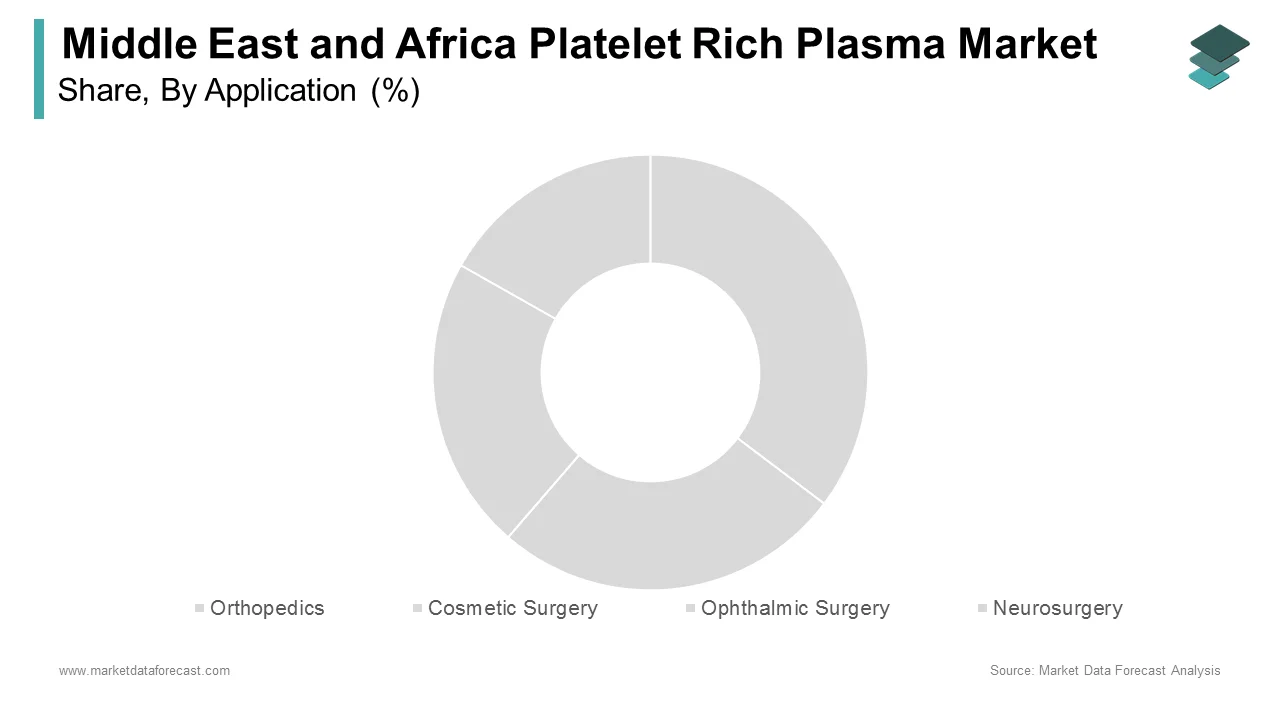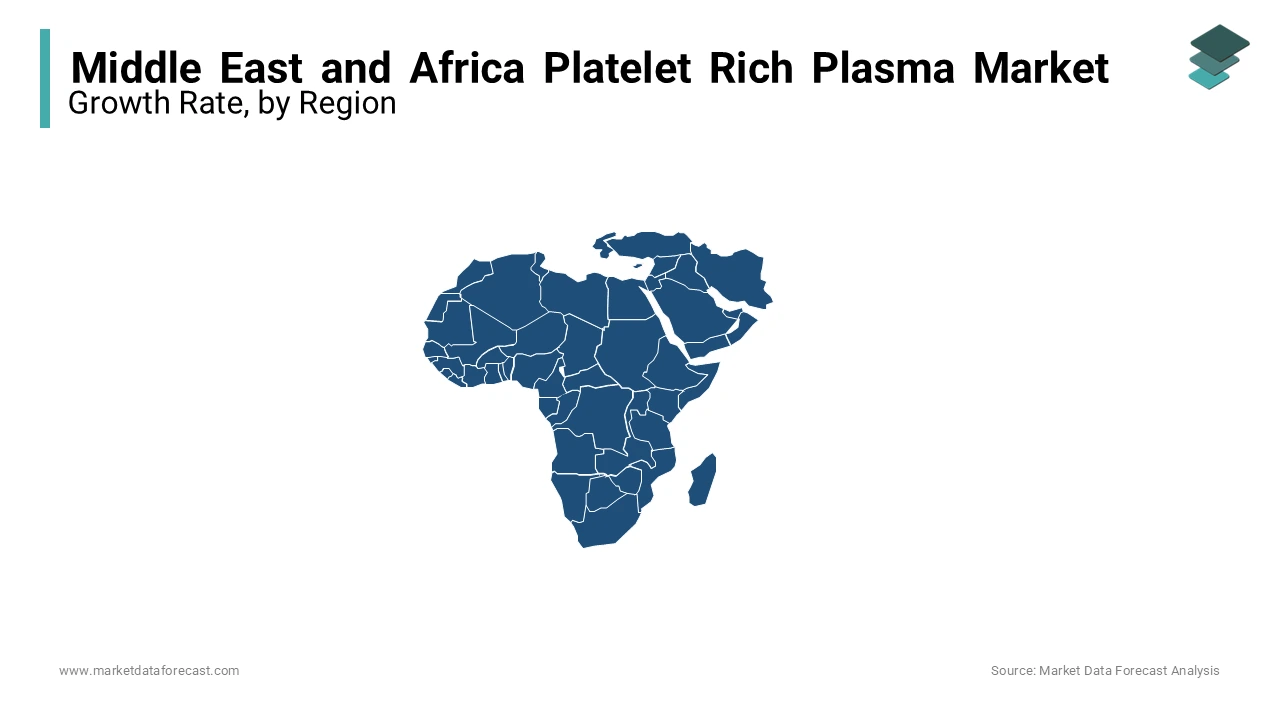Middle East and Africa Platelet Rich Plasma (PRP) Market Size, Share, Trends & Growth Forecast Report By Application, Product, Origin & Country (KSA, UAE, Israel, rest of GCC countries, South Africa, Ethiopia, Kenya, Egypt, Sudan, rest of MEA), Industry Analysis (2025 to 2033)
Middle East & Africa Platelet-Rich Plasma Market Size
The Middle East and Africa platelet-rich plasma market was valued at USD 21.7 million in 2024. The MEA market size is estimated to grow from USD 24 million in 2025 to USD 54.5 million by 2033, growing at a CAGR of 10.8% from 2025 to 2033.

Platelet-rich plasma (PRP) therapy, an innovative medical treatment utilizing a blood component of the patient to promote healing, is gaining traction in the Middle East and Africa. This autologous therapy involves concentrating platelets to release growth factors that facilitate tissue repair and regeneration. In the African region, blood safety and availability remain critical concerns. The World Health Organization (WHO) reports that the median blood donation rate in low-income countries is 4.6 donations per 1,000 people, significantly lower than the 33.1 donations per 1,000 people in high-income countries.
MARKET DRIVERS
Growing Demand for Aesthetic and Cosmetic Procedures
The rising interest in non-invasive aesthetic and cosmetic procedures is a significant driver of the platelet-rich plasma (PRP) market in the Middle East and Africa (MEA). According to the International Society of Aesthetic Plastic Surgery, the MEA region has seen a consistent increase in cosmetic treatments, with PRP gaining popularity for skin rejuvenation and hair restoration. The natural approach of PRP to stimulating collagen and repairing damaged tissues matches the preference for minimally invasive solutions in the Middle East and Africa. The demand for PRP therapies is expected to accelerate across both urban and emerging healthcare sectors due to the increasing awareness of PRP’s effectiveness in addressing age-related skin concerns and alopecia.
Rising Prevalence of Chronic Wounds and Diabetes
The prevalence of diabetes and associated chronic wounds is escalating in the MEA region and is driving the adoption of PRP therapy as an advanced wound care solution. According to the World Health Organization, the adult diabetes prevalence rate in the Middle East and North Africa is approximately 13.7%, one of the highest globally. Diabetes often leads to chronic wounds and requires innovative treatments such as PRP for effective healing. The ability of PRP to enhance tissue regeneration and promote faster recovery makes it an essential tool for addressing diabetic ulcers and other chronic wound complications and further fuelling the demand for PRP in the region.
MARKET RESTRAINTS
High Cost of PRP Therapies
The elevated expenses associated with Platelet-Rich Plasma (PRP) treatments present a significant barrier to their widespread adoption in the Middle East and Africa. As per the World Health Organization, out-of-pocket health expenditure in the region is substantial, which makes procedures such as PRP expensive and less accessible to the general population. This financial burden limits patient uptake and poses challenges for healthcare providers aiming to offer advanced regenerative therapies.
Limited Standardization and Quality Control
The absence of standardized protocols and quality control measures in PRP preparation and application hampers market growth in the MEA region. The World Health Organization emphasizes the importance of quality assurance in medical treatments to ensure patient safety and efficacy. Variations in PRP preparation techniques can lead to inconsistent treatment outcomes, reducing clinician and patient confidence in these therapies. This lack of uniformity poses a significant restraint to the broader acceptance and utilization of PRP treatments.
MARKET OPPORTUNITIES
Government Initiatives Promoting Medical Tourism
Several Middle Eastern countries, notably the United Arab Emirates and Saudi Arabia, are actively promoting medical tourism by investing in advanced healthcare infrastructure and services. This strategic focus attracts international patients seeking innovative treatments, including Platelet-Rich Plasma (PRP) therapies. The World Health Organization highlights that such initiatives enhance the quality and accessibility of medical services, positioning the region as a hub for medical tourism. This influx of international patients seeking PRP treatments contributes to market growth and underscores the region's potential in the global healthcare landscape.
Expanding Research and Development in Regenerative Medicine
The Middle East and Africa are witnessing increased investment in research and development within the field of regenerative medicine, encompassing PRP therapies. Government agencies and private institutions are establishing research centers and funding studies to explore the efficacy and applications of PRP in various medical disciplines. The World Health Organization notes that such investments in medical research contribute to the development of innovative treatments and enhance the region's capacity to address complex health challenges. This focus on R&D not only drives market growth but also positions the region as a contributor to advancements in medical science.
MARKET CHALLENGES
Limited Awareness and Acceptance of PRP Therapies
In the Middle East and Africa (MEA), a significant challenge to the adoption of Platelet-Rich Plasma (PRP) treatments is the limited awareness among both healthcare professionals and patients. The World Health Organization emphasizes that enhancing health literacy is crucial for the effective implementation of new medical technologies. Without an adequate understanding of PRP's benefits and applications, its utilization remains restricted, hindering market growth.
Regulatory and Ethical Challenges
The regulatory landscape for PRP therapies in the MEA region is often underdeveloped, leading to inconsistencies in treatment protocols and ethical concerns. The World Health Organization highlights the importance of robust regulatory frameworks to ensure the safety and efficacy of medical treatments. Inadequate regulations can result in variable treatment outcomes and diminished trust among patients and healthcare providers, posing a significant challenge to the market's expansion.
SEGMENTAL ANALYSIS
By Application Insights

The orthopedics segment had the dominating share of the regional market in 2024. The lead of the orthopedics segment is primarily attributed to the high prevalence of musculoskeletal disorders and sports-related injuries in the region. PRP therapy is increasingly utilized in orthopedic treatments to enhance healing in conditions such as osteoarthritis, tendonitis, and ligament injuries. The World Health Organization reports that musculoskeletal conditions are a leading contributor to disability worldwide, significantly impacting the MEA region.
However, the cosmetic surgery segment is emerging as the fastest-growing segment in the Middle East and Africa PRP market. This rapid expansion is driven by increasing consumer demand for aesthetic enhancements and a rising preference for minimally invasive procedures. PRP is widely applied in cosmetic treatments, including facial rejuvenation and hair restoration, due to its regenerative properties. The World Health Organization notes a global rise in elective cosmetic procedures, reflecting similar trends in the MEA region.
By Product Insights
The Pure PRP segment held the leading share of the Middle East & Africa PRP market in 2024. The domination of the Pure PRP segment is majorly attributed to its wide application across orthopedics, dermatology, and dentistry due to its high platelet concentration and minimal leukocyte presence, which reduces inflammation. Pure PRP is increasingly used for chronic wound healing, with the World Health Organization highlighting a rise in non-communicable diseases like diabetes, where chronic wounds are common. This rising demand for non-surgical, effective healing methods reinforces the dominance of Pure PRP in the region, emphasizing its pivotal role in advancing regenerative medicine solutions.
By Origin Insights
The autologous PRP segment led the Middle East and Africa PRP market in 2024 due to its reliance on the patient’s own blood, minimizing risks of immune reactions or disease transmission. As per the World Health Organization, using autologous blood-based products enhances safety by eliminating cross-contamination risks. The applications of Autologous PRP in orthopedics, chronic wound care, and cosmetic procedures, combined with its efficiency in promoting tissue repair and regeneration, reinforce its leading position in the market. Its popularity stems from the increasing preference for personalized and minimally invasive treatments, which cater to diverse medical needs.
The allogeneic PRP segment is poised to grow at the fastest rate in the Middle East and African market over the forecast period. The growth of the segment is driven by its ease of availability and suitability for immediate use, addressing urgent medical requirements. According to the World Health Organization, the global demand for safe and effective blood-derived products has increased, spurring research and development in allogeneic PRP therapies. Unlike autologous PRP, allogeneic PRP can be produced in bulk from donor blood, facilitating broader accessibility and enabling standardized applications in regenerative medicine. Its potential to streamline treatment protocols makes it a promising avenue in advancing healthcare delivery.
REGIONAL ANALYSIS
Saudi Arabia stands as the largest market for Platelet-Rich Plasma (PRP) in the Middle East and Africa region. This leadership is driven by the country's substantial investments in healthcare infrastructure and a growing demand for cosmetic procedures. According to a study published in the International Journal of Medicine in Developing Countries, Saudi Arabia ranks 22nd among the top 25 countries for the highest rate of plastic surgeries, with 23,626,909 cosmetic procedures performed. Additionally, the government's encouragement of sports activities has led to an increase in sports-related injuries, further boosting the demand for PRP therapies.

The United Arab Emirates is experiencing the fastest growth in the PRP market within the region. This rapid expansion is attributed to the UAE's strategic focus on becoming a medical tourism hub, coupled with advancements in healthcare services. The government's Vision 2021 initiative emphasizes the development of a world-class healthcare system, attracting international patients seeking advanced treatments, including PRP therapies. The UAE's commitment to healthcare excellence and its strategic investments in medical infrastructure are key factors propelling the swift growth of the PRP market in the country.
KEY MARKET PLAYERS
Companies playing an important role in the MEA platelet-rich plasma market profiled in this report are DR. PRP AMERICA, LLC, Glofinn Oy, Zimmer Biomet, DePuy Synthes, Emcyte Corporation, Terumo BCT, Anthrex Inc, T-Biotechnology, and Stryker.
MARKET SEGMENTATION
This research report on the Middle East and Africa platelet-rich plasma market has been segmented and sub-segmented into the following categories.
By Application
- Orthopedics
- Cosmetic Surgery
- Ophthalmic Surgery
- Neurosurgery
By Product
- Pure
- Leukocyte-Rich
- Leukocyte-Rich Fibrin
By Origin
- Homologous PRP
- Autologous PRP
- Allogeneic PRP
By Country
- KSA
- UAE
- Israel
- rest of GCC countries
- South Africa
- Ethiopia
- Kenya
- Egypt
- Sudan
- rest of MEA
Related Reports
Access the study in MULTIPLE FORMATS
Purchase options starting from
$ 1600
Didn’t find what you’re looking for?
TALK TO OUR ANALYST TEAM
Need something within your budget?
NO WORRIES! WE GOT YOU COVERED!
Call us on: +1 888 702 9696 (U.S Toll Free)
Write to us: sales@marketdataforecast.com
